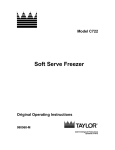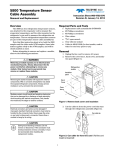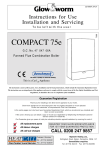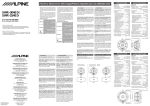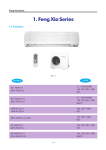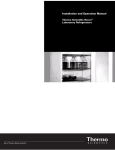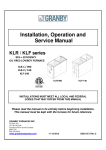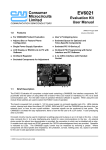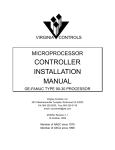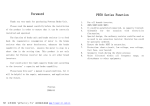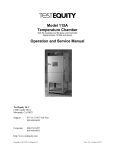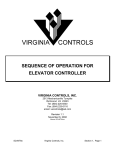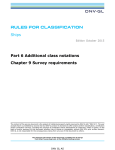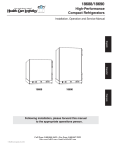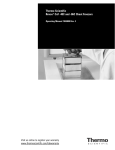Download 7998600 Rev. 4
Transcript
7998600 Rev. 4 The material in this manual is for information purposes only. The contents and the product it describes are subject to change without notice. Thermo Electron Corporation makes no representations or warranties with respect to this manual. In no event shall Thermo be held liable for any damages, direct or incidental, arising out of or related to the use of this manual. MANUAL NO. 7998600 4 3 2 ---1 0 FR-1789 22216 22179 REV ECR/ECN 21605 6/27/05 3/22/04 2/24/04 8/21/03 8/13/03 6/27/03 5/29/03 3/21/03 DATE Revised VRP troubleshooting section for Release 3 Added 120V 23 cu. ft. units Revised electrical schematic, start capacitor part number Door gap, high stage revisions Revised compressor information page B-1 Revisions per A. Thomas Wrong power alarm modifications New manual aks aks aks aks aks aks aks aks DESCRIPTION BY ii Table of Contents Section 4 -Hidden Functions 4.1 Hidden Test ........................................... 4-1 4.2 Hidden Calibration ................................ 4-2 Section 1 – General Operation 1.1 Initial Start Up...................................... 1-1 1.2 Equipment Explanation......................... 1-1 1.3 Operating Pressure “High and low stage systems”............... 1-1 Appendix A - Glossary Glossary of terms ........................................ A-1 Section 2 – Troubleshooting Charts 2.1 Probe 1,2,3, and 4 failure alarm (Single) ............................................... 2-1 2.2 Probe 1,2,3, and 4 failure alarm (All probes) .......................................... 2-1 2.3 Unit will not communicate with alarm system ................................................. 2-2 2.4 Display/Keyboard not functioning ....... 2-3 2.5 Door ajar alarm.................................... 2-4 2.6 No door access .................................... 2-5 2.7 Low battery alarm................................ 2-6 2.8 Noise ................................................... 2-6 2.9 Hot condenser alarm ............................ 2-7 2.10 High stage system failure alarm ........... 2-8 2.11 Power failure alarm.............................. 2-9 2.12 Wrong power ....................................... 2-10 2.13 Low Temperature................................. 2-10 2.14 High temperature alarm or system not maintaining temperature ...................... 2-11 2.15 Troubleshoot compressor ..................... 2-13 2.16 Voltage Compensation Failure ............. 2-14 Appendix B Compressor Information .............................. B-1 Section 3 – Charts and Schematics 3.1 Analog Output Reference Table ............. 3-1 3.2 RTD Temperature vs. Resistance ........... 3-2 3.3 Pressures vs. Cabinet Temperature......... 3-3 3.4 Refrigeration Schematics ....................... 3-4 3.5 Electrical Schematics ............................ 3-6 3.6 Micro Board .......................................... 3-8 3.7 High Voltage Board ............................... 3-8 iii General Operation 1.1 Initial Start Up 1. Power Switch on. 2. Cabinet temperature 0.5°C or warmer than set point. 3. Fans 1 and 2 turn ON. 4. High stage compressor turns ON, after ten seconds delay. 5. Low stage compressor turns ON when: A. Thirty seconds after high stage starts and heat exchanger probe reads –41°C or colder or B. Five minutes after high stage starts and heat exchanger probe reads between –33°C to –40°C. If heat exchanger probe warms-up to –20°C or warmer, the low stage compressor shuts down until either condition 5A or 5B is met. After thirty minutes, if condition 5A or 5B is not met, the high stage system failure will be activated. 6. Once the cabinet temperature reaches –50°C, the*expansion tank solenoid is opened (de-energized). The vacuum relief heater and mullion heater on double door units, are energized and operate continuously until the cabinet is warmer than –50°C. 7. Set point achieved, fans and compressors cycle off. 8. Steps 2 though 7 repeat (cycle). *Items or functions unique to this system 1.2 Expansion Tank Assembly and Solenoid Valve Location: Suction side of low stage system. Purpose: Tank assembly increases low stage system refrigeration capacity. Prevents excessive low stage pressures at temperatures warmer than –50°. Operation: The tank assembly solenoid valve is normally open. The solenoid valve is energized (closed) when the control probe senses temperature warmer than –50°C. The solenoid valve is de-energized (open) when the control probe senses temperature colder than –50°C. 1.3 Operating Pressure “High and low stage systems” The suction side pressure for both systems typically runs in a vacuum. Prior to opening a system for a pressure reading, always purge your lines according to the manufacturer’s recommended procedure. For further information, call Thermo Forma Service Department. 230 Volt Freezers Only the compressors require 230 volts. The remaining high voltage components operate using 115 volts. 1-1 2.1 Symptom: Probe 1, 2, 3, or 4 Failure Alarm - SINGLE PROBE FAILURES Order 1 2 3 Possible Cause Verification Action Unplugged. Re-seat connector. Re-seat all connections. Not fully seated Verify wires are fully seated in connectors and connectors are seated together Replace probe if necessary. Short. Open. Display reads 99. Verify probe resistance. See Temperature vs. Resistance Chart (Page 3-2). Replace probe. Wrong value. Verify probe resistance. See Temperature vs. Resistance Chart (Page 3-2). Replace probe. Micro board. Temporarily switch suspect probe with control or heat exchanger probe. If the same error exists, replace micro board. Probe Bad probe 2.2 Symptom: Probe 1, 2, 3, and 4 Failure Alarm – (ALL PROBES FAIL) Order 1 Possible Cause Verification Control probe not installed. Re-seat connector. Verify wires are fully seated in connectors and connectors are seated together. Startup only. 2 Bad control probe Short. Open. Wrong value. 3 4 Action Display reads 99. Bad control probe will also cause a high temperature alarm and lock both compressors on. Verify probe resistance with Temperature vs. Resistance Chart (page 3-2). Reinitialize (re-start) unit. Reseat all connections. Replace probe if necessary. Replace probe. Micro board. Temporarily switch control probe with heat exchanger probe. If the same error exists, replace micro board. Micro board EEPROM Problem still exists after re-initializing unit. Re-initialize eeprom in test mode. If problem remains, replace the micro board. Note: all calibration, set points and configuration are set to default. 2-1 2.3 Symptom: Unit will not communicate with alarm system (Remote Alarm Contacts/Analog System/Serial communication) Order 1 2 3 Possible Cause Verification Action Remote Alarm Contacts Check that all connections are tight and properly wired. Missing wires? Tighten and / or correct wiring. Measure continuity of alarm contacts between pins 6 & 7 and 6 & 8 while toggling in test mode (pin 6 is common). Replace micro board if contacts do not change state. Verify the setting is correct in hidden calibration and corresponds to the dip switch settings on the micro board per the electrical schematic. Measure output. Compare with Analog Output Reference Table (page 3-1). Make changes so the dip switch settings and hidden calibration settings match. Check that all connections are tight and properly wired. Missing wires? Tighten and / or correct wiring. Verify address is correct in configuration menu and matches the 1535 address. Change so that the unit address of the freezer matches the 1535 address. Verify the setting is correct in hidden calibration and corresponds to the dip switch settings on the micro board per the electrical schematic. Check that all connections are tight and properly wired. Missing wires? Tighten and / or correct wiring. Verify that the cable is a DB9 (straight through) extension cable. Make changes so that the dip switch settings and hidden calibration settings match. Analog Output Serial Communication 2-2 Call the factory service department 888-213-1790. See section 4.2.p Analog Calibration (page 4-3). Tighten and / or correct wiring. Replace cable if necessary. 2.4 Symptom: Display / Keyboard Not Functioning Order 1 2 3 4 5 Possible Cause Verification Action Turned battery on before AC power is applied. (initial start up issue only) No AC power and no battery power. Ask customer/end user. Turn unit power off. Turn battery off. Reapply AC power before the battery is turned on. Verify supply AC voltage is present. Supply correct line voltage. +14VDC on switching power supply. If not, replace switching supply. +14VDC on micro board at connector labeled DC power from HV board (pins 1 and 6). Is unit operating (fans, compressors)? Check connector seating on ribbon cables. Replace if required. Micro board Micro LED LD1 on micro board not functioning. Micro board - Micro LED LD1 functioning / no display LED LD2. If no, replace micro board. If yes, continue to step 4. Turn unit off, then turn unit back on. Miscellaneous characters displayed. Replace display board. Check connection of 25 pin D sub cable at both ends. Waiting Comm is displayed. Replace micro and/or display as needed. Display Missing segment Visual. Replace display board. Keys not responding Check continuity for buttons on overlay. Replace overlay. LEDs not functioning Ohm out LEDs. Replace overlay. No Alarm Press any key on overlay. If no audible, replace display board. 2-3 2.5 Symptom: Door Ajar Alarm Order Possible Cause Verification Action 1 2 No magnet Visually inspect for magnet in door handle. Replace magnet as required. Worn door handle Inspect inside of door latch for signs of metal (aluminum) wear (wobbly handle). Replace latch if necessary and verify vacuum relief port operation, as well as the door alignment. 3 Improper connection Wires loose from door switch connector. Verify wires are properly seated in connector. If required, re-seat the wire connection. Verify connectors are seated together. Re-seat connection. Verify the plug is in the correct receptacle. Re-seat plug in correct receptacle. Verify door gap. Single door .600” Double door .700”, both measured from the hinge side. Verify continuity on door switch by opening and closing door. Short out door switch connector. Make adjustment as required. Door switch connector not seated to board connector. Installed in wrong connector 4 Improper door alignment 5 6 Bad door switch Defective micro board. 2-4 If no continuity of switch during opening and closing of door, replace door switch. If alarm does not clear replace micro board. Or else repeat starting at Step 1. 2.6 Symptom: No Door Access Order Possible Cause Verification Action 1 2 Door locked. Check to ensure door is not locked. Unlock door. Vacuum relief assembly is frozen over. Visually inspect vacuum relief port for any restrictions. 3 Release 3 unit: Vacuum relief not functioning. Release 3 units(built after 6/2005 have vacuum relief port in door. Check voltage at J7 on the display board for +14V + 0.5? YES (+14V): unplug heater harness from PCB and measure resistance across heater leads. Heater resistance should be between 9 and 30 Ohms. NO: Check and reseat connections on heater harness. Measure DC voltage at the switching power supply. On the 6 pin connector, measure between pins 1 and 6 (+14V + 0.5V) Verify unit is colder than –50°C. Clean as necessary. Follow routine maintenance instructions in user’s manual to periodically clean the port. If not between 9 and 30 Ohms, replace VRP assembly. Release 1 unit: Vacuum relief not functioning. Release 2 units built between May 2003 and June 2005 do not use a heated vacuum relief assembly. Check and reseat connectors between switching power supply and high voltage board. Also check and reseat connections between high voltage board and micro board. Cabinet temperature must be colder than –50°C to activate vacuum relief heater. 90-130VAC at heater? YES: Ohm out heater. Heater to be 1037-1210 Ohms Replace heater if required. NO: Check connections Re-seat connection(s). If problem still exists, continue troubleshooting. Blown fuse Check fuse. Ohm out fuse, replace fuse as required. Micro board Check voltage between U16-13 and J11-1 on micro board. Check DC voltage across D15 on high voltage. If voltage is greater than 10VDC, replace micro board. If voltage is less than 10VDC, replace high voltage board. High voltage board. 2-5 2.7 Symptom: Low Battery Alarm Order Possible Cause Verification Action 1 2 3 4 New battery / new unit or freezer just placed into service? Missing battery Ask customer/end user. Complete steps 2,3, & 4. Visually look for battery. If yes, batteries required 36 hours for charging. If no, continue to step 5. Install battery. Battery switch turned off. Verify switch is “on”. Turn switch on after AC power is applied. Connection – Wires making connection. Battery wired backwards. Ensure connections are tight at the battery, battery switch, and micro board. Verify the red wire is connected to the positive terminal. Tighten and change wiring as needed. 5 6 7 8 Battery switch defective. Verify continuity with multimeter. Replace switch. Battery Calibration Measure voltage at the battery and compare to the value displayed in hidden calibration. Check voltage at the battery during battery test after 2 days (48 hours) of operation. Disconnect battery and measure voltage at the battery wires. Match values. Battery voltage < 12.1 during battery test. Micro board – Battery test circuit. Battery charging circuit If voltage < 12.1, replace battery and continue to step 8. If 13.5 - 13.8 VDC is present, replace battery. If not present replace micro board and battery. 2.8 Symptom: Noise Order Possible Cause Verification Action 1 2 Loose screws on panels or compressors. Ensure all screws and bolts are tightly secure. Tighten as needed. Missing or no sound insulation. Add foam panels if necessary. 3 Start capacitor on compressor. 4 5 6 Electrical cover on compressors. Remove side panels to ensure insulation is present. Inspect the bottom of cabinet to verify insulation is present. Ensure capacitor is not touching the compressor body and capacitor bracket securely holds the capacitor. Ensure cover is tight. Vibrating refrigeration lines. Inspect for lines that are touching. Adjust as necessary. Solenoid Ensure that the solenoid base sits on presstite tape and is tie wrapped to the freezer base. Replace presstite tape and tie wraps, if necessary. 2-6 Adjust as needed. Tighten as needed. 2.9 Symptom: Hot Condenser Alarm Order Possible Cause Verification Action 1 High ambient. Move to cooler location / lower ambient. Educate customer. 2 Restricted / reduced airflow. Measure ambient temperature. Is ambient above 33°C? Alarm will cycle with compressors. If ambient is above 37°C, alarm is on constantly. Check filter. Change / clean filter. Check for condenser blockage. Remove blockage. Verify clearance specifications of 5 inches are met. Install stand-offs. Check for open front panel. Close front panel. Confirm High stage is on (fans should be running) Identify problem fan(s) Confirm voltage to each fan by verifying voltage at pins J29-1 to J29-7 and J29-2 to J29-8 on the high voltage board. Start unit to continue, if off. Method ( tie wrap…) If no voltage, check voltage between U13-10 and J11-1, U16-10 and J11-1 on micro board. If less than 10VDC, replace micro board. Else if DC voltage across D11 and D14 on high voltage board is less than 10VDC, check ribbon cable. If ribbon cable OK, replace high voltage board. 3 Fan(s) not running. If voltage exists, measure Ohms for fans at connector that plus into J29 on high voltage board. First column of black wires for fan in front of high stage, second column of black wires for fan in front of low stage. Ohms should be 130 to 145 in 23°C. Replace fan(s) with improper Ohms. 4 Defective probe. See: Probe 1,2,3, or 4 failure alarm troubleshooting chart. Condenser probe plus into J4 of micro board. 2-7 2.10 Symptom: High Stage System Failure Alarm Order 1 2 3 Possible Cause Verification Action Clear HS System Failure Alarm in Configuration Mode. Fan(s) not running. See procedure for troubleshooting fans under “Hot Condenser” alarm. High stage compressor not starting or not running. Inadequate power at the customer’s site. AC power to high stage compressor. If required, go into test mode; turn both fans and high stage compressor on. Check voltage at the wall and monitor for large voltage drop during start-up. No voltage at compressor. LD2 and LD4, on high voltage board, are not on. No voltage at compressor, LD5 (HS) on high voltage board is on. No voltage at compressor LD5 (HS) is off and should be on. Voltage at compressor 4 HS compressor cycles on highpressure cutout. HX probe reading incorrectly. Install pressure gauges on high stage and verify that high-pressure cutout is functioning normally. Compare T/C reading on interstage heat exchanger to resistance of HX probe and display value. See Resistance to Temperature Chart (page 3-2). 2-8 If voltage drops below 90V for 120V units or 180V for 230V units, contact customer. Line voltage is within specified limits For LD2 measure voltage between U13-12 and J11-1, for LD4 measure voltage between U13-14 and J11-1, on micro board. If voltage is less than 10VDC, replace micro board. If voltage is greater than 10VDC, for LD2 measure voltage from right side of D3 to right side of D4, for LD4 measure from right D7 & right side of D8 on high voltage board. If voltage is less than 10VDC, check ribbon cable. Ribbon cable OK, replace high voltage board. Check connections: enclosure, high pressure cutout switch. Ohm out pressure switch. Switch to be closed. Switch OK, measure voltage between pins 4 and 5 of J30. If no voltage, replace high voltage board. Switch defective; jumper around switch and continue to test. If voltage between U13-15 and J11-1, on micro board, is less than 10VDC, replace micro board. Else, if DC voltage across D12 on high voltage board is greater than 10VDC, check ribbon cable. If ribbon cable OK, go to previous verification. Else, if D12 voltage less than 10VDC, replace high voltage board. Check continuity of compressor thermal switch. Check winding resistance of compressor. See Appendix B Check compressor-starting hardware. Replace parts as needed. Replace defective high-pressure cutout. If T/C differs from resistance and displayed value, defective probe. If displayed value differs from T/C and resistance value, replace micro board. 2.10 Symptom: High Stage System Failure Alarm (continued) Order 5 Possible Cause Verification Action Restriction in high stage capillary tube. Measure the temperature at the heat exchanger. If a restriction exists, the heat exchanger will be warmer than normal. Recondition high stage. 2.11 Symptom: Power Failure Alarm Order 1 2 Possible Cause Verification Action Unplugged line cord. Check that line cord is properly seated in wall connection and relay enclosure. Verify switch / circuit breaker (power switch) by continuity or test for line voltage on high voltage board where wires from switch are connected to board. Re-attach line cord and install strain relief per user’s manual, if required. Replace if required. Verify switch / circuit breaker does not trip below amperage rating. Replace if required. If trips above rating, go to step 5. Unit circuit breaker (power switch). 3 Loose wires Circuit Breaker/ Power switch. High voltage board. Switching power supply. Verify line voltage connection from circuit breaker/power switch to high voltage board inputs and ribbon cable connection from high voltage board to DC switching power supply. Seat or replace as required. 4 Defective switching power supply. Verify input line voltage and output voltage, +14 VDC, is present at switching power supply. Replace if required. 5 6 Damaged components or wiring. Inspect relay enclosure for damaged components and wiring. Check both stages for L.R.A. Replace as required. 7 Facility Wiring Circuit breaker Wire. Defective starting hardware or compressor(s). Dedicated circuit and correct rating? If compressor attempts to run and draws L.R.A., check start relay for proper operation and values on start and run capacitors. Ohm compressor windings and compare to nominal values (Appendix B). Advise customer. Connections, gauge size, and length. Try a different circuit. Fix as required. 2-9 2.12 Symptom: Wrong Power Order Possible Cause Verification Action 1 2 Sequence that battery and power switch was turned on (start-up only) Facility wiring incorrect. 230V receptacle 115 supply Was battery switch turned on before power switch was turned on? Proper line voltage. Turn both switches off. Turn power switch on, then turn battery switch on. Need correct operation voltage. 3 4 Wrong line cord set. Verify correct line cord plug : P5-15 (120V,15A), P5-20 (120V,20A), P6-15 (230V,15A). Cables properly seated. Contact manufacturer. 5 High voltage board failure. Ribbon cables damaged. Measure AC voltage between left side F1 and left side of R9. Voltage should be between .25 and .95 VAC. Measure frequency between pins 4 and 5 of U1. Replace cable(s). If incorrect voltage, replace high voltage board. 6 Ribbon cable connection between high voltage and micro board. Micro board failure. Reseat connections. Measure AC voltage across R40 on micro board. Voltage should be between .25 and .95 VAC. Frequency is not twice the frequency of wall outlet. Replace high voltage board. No voltage: replace ribbon cable. Good voltage: replace micro board. Measure frequency between pin 10 of U14 and pin 8 of U28.. No measurement, check ribbon cable. If ribbon cable is ok, replace micro board. 2.13 Symptom: Low Temperature Alarm Order Possible Cause Verification Action 1 Relays on high voltage board not being turned off. Verify that LEDs (LD5 and LD6) on the high voltage board are illuminated and voltage across D12 and D13 is greater than 10VDC. IF LD5 and LD6 on and voltage is greater than 10DC, replace micro board. If LD5 and LD6 are off and voltage is less than 10VDC, replace high voltage board. 2 Wrong probe value Verify probe resistance with Temperature vs. Resistance Chart (page 3-2). Replace as required. 2 - 10 2.14 Symptom: High Temperature Alarm or System is not maintaining temperature Order 1 2 3 4 Possible Cause Verification Action Door Inspect gasket for ice or excessive frost. Clear ice or frost from door and gasket. Check door adjustment: fit and gasket compression. Frequency and duration of door openings and product loading (size of load and temperature of introduced product. If customer usage is high or suspected as high, then verify actual performance with a datalogger. Install thermocouple at control sensor and verify control RTD temperature is accurate. Adjust door to restore uniform gasket compression. Load – evaluate customer usage. Defective control probe Normal relay(s) on high voltage board See procedure for troubleshooting probes “Probe 1,2,3 or 4 Failure (Single Probe). LD 2 and LD 4 on high voltage board are not lit 120v units: Line voltage 105 - 140 230V/60Hz units: Line voltage 210 - 260 230V/50Hz units: Line voltage 190- 230 2 - 11 Work with customer to communicate effects of loading. Troubleshoot control probe with “Probe 1,2,3 & 4 failure procedure”. Line voltage is within specified limits For LD2 check voltage between U13-12 and J11-1 on micro board, for LD4 measure between U13-14 and J11-1, if voltage is less than 10VDC, replace micro board. If voltage is greater than 10, then check DC voltage from right side of D3 to right side of D4 (LD2), from right D7 & right side of D8 (LD4) on high voltage board. If is less than 10VDC, check ribbon cable. If ribbon cable OK, replace high voltage board. 2.14 Symptom: High Temperature Alarm or System is not maintaining temperature (continued) 5 AC power to low stage compressor. No voltage at compressor, LD6 (LS) on high voltage board is on. No voltage at compressor LD6 (LS) is off and should be on. Voltage at compressor 6 7 LS compressor cycles on high-pressure cutout. High stage refrigeration system failure Low Stage refrigeration system failure Install pressure gauges on low stage and verify that high-pressure cutout is functioning normally. Verify interstage heat exchanger temperature is above –33°C. Verify interstage heat exchanger temperature is below –33°C. 2 - 12 Check connections: enclosure, high-pressure cutout switch. Ohm out pressure switch. Switch to be closed. Switch OK, measure voltage between pins 1 and 2 of J30. If no voltage, replace high voltage board. Switch defective; jumper around switch and continue to test. If voltage between U13-16 and J11-1, on micro board, is less than 10VDC, replace micro board. If voltage greater than 10, check DC voltage across D13 on high voltage board is less than 10VDC, check ribbon cable. If ribbon cable OK, go replace high voltage board If D13 voltage greater than 10VDC, . Go to previous verification, LD6 maybe defective. Check continuity of compressor thermal switch. Check winding resistance of compressor. See Appendix B Check compressor-starting hardware. Replace parts as needed. Replace defective high-pressure cutout. Troubleshoot with “Troubleshooting Compressor”. Troubleshoot with “Troubleshooting Compressor”. 2.15 Symptom: Troubleshoot compressor Order Possible Cause 1 Low suction pressure problem 2 Unit at room temperature, heat exchanger at room temperature 3 Compressor Starting Problem Verification Action Verify compressor starts and run continuously. If yes, install gauges and go to next step. If no, go to order 3 of “Compressor starting problem”. Verify suction pressure is above: High Stage – 0 psig Low Stage – 10” vac If suction pressure is “ok”, proceed to next step. If suction pressure is below limits, conduct equalization test: if equalization test fails – blocked cap tube; recondition refrigeration system. If equalization test passes, warm unit, go order 2 “unit at room temp, heat exchanger at room temp”. Verify discharge pressure is below 175 psig – conduct efficiency test. Suspect bad compressor (values): replace compressor…recondition refrigeration system. If discharge pressure is above: LS 175 psig HS 250 psig Verify static pressures are acceptable. Suspect non-condensables: recondition the refrigeration system in question. Recondition low stage (suspect partial restriction in cap tube). Compare high stage static and low stage static pressures. Are the static pressures on high and low stages identical? Static pressure unacceptable. Measurements of wall voltage Unit off Unit at start-up. Verify compressor attempts to start (draws L.R.A. or turns over briefly). Yes, replace interstage and recondition both the high and low stages. No, go to next verification. Suspect under- or overcharge. Recondition refrigeration system for system in question. If unacceptable, work with customer to correct. If acceptable, go to next step. If compressor attempts to run and draws L.R.A., check start relay for proper operation and values on start and run capacitors. If no attempt to start – Check voltage to compressor If voltage at compressor, isolate compressor. Ohm compressor windings at compressors and compare to nominal values (Appendix B). No voltage at compressor LD5 (HS) or LD6 (LS) is on. Check connections: enclosure, high pressure cutout switch. Ohm out pressure switch. Switch to be closed. No voltage at compressor LD5 (HS) or LD6 (LS) is off. 2 - 13 Voltage between U13-15 (HS) or U13-16 (LS) and J11-1 on micro board is less than 10VDC, replace micro board. Else if DC voltage across D12 (HS) or D13 (LS) on high voltage board is less than 10VDC, replace high voltage board. 2.15 Symptom: Troubleshoot compressor continued Order Possible Cause 3 Verification Action Verify if compressor tripping on high pressure switch and confirm that discharge is reaching 375 psig (+ 25 psi).If tripping on pressure switch and discharge pressure is high, then troubleshoot why discharge pressure is high. Verify if compressor is tripping on thermal switch. If tripping on high pressure switch and pressure is not running at 375 psig (+25), then replace pressure switch. If yes, recondition low stage. If no, troubleshoot high voltage board (board turning compressor off). 2.16 Symptom: Voltage Compensation Failure 1 Voltage Compensation Failure Unit will operate normally Turn unit off, and then back on. If unit goes into Boost (LD2 & LD3) or Buck (LD1 & LD4), unit does not function and then goes into Normal mode (LD2 & LD4). Check wiring between transformer(s) and high voltage board Check transformer Check relay contacts. Restart unit. Take following readings when LD1 or LD3 should be on. LD1: Line voltage should be read between J5 and J22 Replace high voltage board as required Turn unit off, and then back on. If unit goes into Boost (LD2) or Buck (LD4), unit does not function and then goes into Normal mode (LD2 & LD4). LD1 or LD3 does not turn on. For LD3, measure voltage between U13-11 and J11-1, for LD1 measure between U13-13 and J11-1, on micro board. If voltage is less than 10VDC, replace micro board. If voltage was greater than 10VDC, for LD1 measure voltage from right side of D1 to right side of D2, for LD3 measure voltage from right D5 & right side of D6 on high voltage board. If the voltage is less than 10VDC, check ribbon cable. If ribbon cable is OK. Replace high voltage board. If voltage between diodes was greater than 10VDC, go to previous verification, LD1 or LD3 maybe defective. 2 - 14 Analog Output Reference Table Temp°C 4-20 mA 50 49 48 47 46 45 44 43 42 41 40 39 38 37 36 35 34 33 32 31 30 29 28 27 26 25 24 23 22 21 20 19 18 17 16 15 14 13 12 11 10 9 8 7 6 5 4 3 2 1 0 20.000 19.893 19.787 19.680 19.573 19.467 19.360 19.253 19.147 19.040 18.933 18.827 18.720 18.613 18.507 18.400 18.293 18.187 18.080 17.973 17.867 17.760 17.653 17.547 17.440 17.333 17.227 17.120 17.013 16.907 16.800 16.693 16.587 16.480 16.373 16.267 16.160 16.053 15.947 15.840 15.733 15.627 15.520 15.413 15.307 15.200 15.093 14.987 14.880 14.773 14.667 4-0mA with 250 Ohm resistor 5.000 4.973 4.947 4.920 4.893 4.867 4.840 4.813 4.787 4.760 4.733 4.707 4.680 4.653 4.627 4.600 4.573 4.547 4.520 4.493 4.467 4.440 4.413 4.387 4.360 4.333 4.307 4.280 4.253 4.227 4.200 4.173 4.147 4.120 4.093 4.067 4.040 4.013 3.987 3.960 3.933 3.907 3.880 3.853 3.827 3.800 3.773 3.747 3.720 3.693 3.667 0-1V 0-5V 1.000 0.993 0.987 0.980 0.973 0.967 0.960 0.953 0.947 0.940 0.933 0.927 0.920 0.913 0.907 0.900 0.893 0.887 0.880 0.873 0.867 0.860 0.853 0.847 0.840 0.833 0.827 0.820 0.813 0.807 0.800 0.793 0.787 0.780 0.773 0.767 0.760 0.753 0.747 0.740 0.733 0.727 0.720 0.713 0.707 0.700 0.693 0.687 0.680 0.673 0.667 5.000 4.967 4.933 4.900 4.867 4.833 4.800 4.767 4.733 4.700 4.667 4.633 4.600 4.567 4.533 4.500 4.467 4.433 4.400 4.367 4.333 4.300 4.267 4.233 4.200 4.167 4.133 4.100 4.067 4.033 4.000 3.967 3.933 3.900 3.867 3.833 3.800 3.767 3.733 3.700 3.667 3.633 3.600 3.567 3.533 3.500 3.467 3.433 3.400 3.367 3.333 Temp°C 4-20 mA -1 -2 -3 -4 -5 -6 -7 -8 -9 -10 -11 -12 -13 -14 -15 -16 -17 -18 -19 -20 -21 -22 -23 -24 -25 -26 -27 -28 -29 -30 -31 -32 -33 -34 -35 -36 -37 -38 -39 -40 -41 -42 -43 -44 -45 -46 -47 -48 -49 -50 14.560 14.453 14.347 14.240 14.133 14.027 13.920 13.813 13.707 13.600 13.493 13.387 13.280 13.173 13.067 12.960 12.853 12.747 12.640 12.533 12.427 12.320 12.213 12.107 12.000 11.893 11.787 11.680 11.573 11.467 11.360 11.253 11.147 11.040 10.933 10.827 10.720 10.613 10.507 10.400 10.293 10.187 10.080 9.973 9.867 9.760 9.653 9.547 9.440 9.333 4-20mA with 250 Ohm resistor 3.640 3.613 3.587 3.560 3.533 3.507 3.480 3.453 3.427 3.400 3.373 3.347 3.320 3.293 3.267 3.240 3.213 3.187 3.160 3.133 3.107 3.080 3.053 3.027 3.000 2.973 2.947 2.920 2.893 2.867 2.840 2.813 2.787 2.760 2.733 2.707 2.680 2.653 2.627 2.600 2.573 2.547 2.520 2.493 2.467 2.440 2.413 2.387 2.360 2.333 3-1 0-1V 0-5V Temp°C 4-20 mA 0.660 0.653 0.647 0.640 0.633 0.627 0.620 0.613 0.607 0.600 0.593 0.587 0.580 0.573 0.567 0.560 0.553 0.547 0.540 0.533 0.527 0.520 0.513 0.507 0.500 0.493 0.487 0.480 0.473 0.467 0.460 0.453 0.447 0.440 0.433 0.427 0.420 0.413 0.407 0.400 0.393 0.387 0.380 0.373 0.367 0.360 0.353 0.347 0.340 0.333 3.300 3.267 3.233 3.200 3.167 3.133 3.100 3.067 3.033 3.000 2.967 2.933 2.900 2.867 2.833 2.800 2.767 2.733 2.700 2.667 2.633 2.600 2.567 2.533 2.500 2.467 2.433 2.400 2.367 2.333 2.300 2.267 2.233 2.200 2.167 2.133 2.100 2.067 2.033 2.000 1.967 1.933 1.900 1.867 1.833 1.800 1.767 1.733 1.700 1.667 -51 -52 -53 -54 -55 -56 -57 -58 -59 -60 -61 -62 -63 -64 -65 -66 -67 -68 -69 -70 -71 -72 -73 -74 -75 -76 -77 -78 -79 -80 -81 -82 -83 -84 -85 -86 -87 -88 -89 -90 -91 -92 -93 -94 -95 -96 -97 -98 -99 -100 9.227 9.120 9.013 8.907 8.800 8.693 8.587 8.480 8.373 8.267 8.160 8.053 7.947 7.840 7.733 7.627 7.520 7.413 7.307 7.200 7.093 6.987 6.880 6.773 6.667 6.560 6.453 6.347 6.240 6.133 6.027 5.920 5.813 5.707 5.600 5.493 5.387 5.280 5.173 5.067 4.960 4.853 4.747 4.640 4.533 4.427 4.320 4.213 4.107 4.000 4-0mA with 250 Ohm resistor 2.307 2.280 2.253 2.227 2.200 2.173 2.147 2.120 2.093 2.067 2.040 2.013 1.987 1.960 1.933 1.907 1.880 1.853 1.827 1.800 1.773 1.747 1.720 1.693 1.667 1.640 1.613 1.587 1.560 1.533 1.507 1.480 1.453 1.427 1.400 1.373 1.347 1.320 1.293 1.267 1.240 1.213 1.187 1.160 1.133 1.107 1.080 1.053 1.027 1.000 0-1V 0-5V 0.327 0.320 0.313 0.307 0.300 0.293 0.287 0.280 0.273 0.267 0.260 0.253 0.247 0.240 0.233 0.227 0.220 0.213 0.207 0.200 0.193 0.187 0.180 0.173 0.167 0.160 0.153 0.147 0.140 0.133 0.127 0.120 0.113 0.107 0.100 0.093 0.087 0.080 0.073 0.067 0.060 0.053 0.047 0.040 0.033 0.027 0.020 0.013 0.007 0.000 1.633 1.600 1.567 1.533 1.500 1.467 1.433 1.400 1.367 1.333 1.300 1.267 1.233 1.200 1.167 1.133 1.100 1.067 1.033 1.000 0.967 0.933 0.900 0.867 0.833 0.800 0.767 0.733 0.700 0.667 0.633 0.600 0.567 0.533 0.500 0.467 0.433 0.400 0.367 0.333 0.300 0.267 0.233 0.200 0.167 0.133 0.100 0.067 0.033 0.000 RTD Temperature vs. Resistance Table For European Curve, Alpha = .00385, ITS-90 1° Celsius Increments Source: http://www.omega.com/temperature/Z/pdf/z252-254.pdf °C °C Ohms Difference Ohms Difference °C Ohms Difference °C Ohms Difference -61 759.30 4.00 -22 913.70 3.90 17 1066.30 3.90 -100 602.60 4.10 -60 763.30 4.00 -21 917.70 4.00 18 1070.20 3.90 -99 606.70 4.10 -59 767.30 4.00 -20 921.60 3.90 19 1074.00 3.80 -98 610.70 4.00 -58 771.30 4.00 -19 925.50 3.90 20 1077.90 3.90 -97 614.80 4.10 -57 775.20 3.90 -18 929.50 4.00 21 1081.80 3.90 -96 618.70 4.10 -56 779.20 4.00 -17 933.40 3.90 22 1085.70 3.90 -95 622.90 4.20 -55 783.20 4.00 -16 937.30 3.90 23 1089.60 3.90 -94 626.90 4.00 -54 787.20 4.00 -15 941.20 3.90 24 1093.50 3.90 -93 631.00 4.10 -53 791.10 3.90 -14 945.20 4.00 25 1097.30 3.80 -92 635.00 4.00 -52 795.10 4.00 -13 949.10 3.90 26 1101.20 3.90 -91 639.10 4.10 -51 799.10 4.00 -12 953.00 3.90 27 1105.10 3.90 -90 643.00 3.90 -50 803.10 4.00 -11 956.90 3.90 28 1109.00 3.90 -89 647.00 4.00 -49 807.00 3.90 -10 960.90 4.00 29 1112.80 3.80 -88 651.10 4.10 -48 811.00 4.00 -9 964.80 3.90 30 1116.70 3.90 -87 655.10 4.00 -47 815.00 4.00 -8 968.70 3.90 31 1120.60 3.90 -86 659.10 4.00 -46 818.90 3.90 -7 972.60 3.90 32 1124.50 3.90 -85 663.10 4.00 -45 822.90 4.00 -6 976.50 3.90 33 1128.30 3.80 -84 667.20 4.10 -44 826.90 4.00 -5 980.40 3.90 34 1132.20 3.90 -83 671.20 4.00 -43 830.80 3.90 -4 984.40 4.00 35 1136.10 3.90 -82 675.20 4.00 -42 834.80 4.00 -3 988.30 3.90 36 1139.90 3.80 -81 679.20 4.00 -41 838.80 4.00 -2 992.20 3.90 37 1143.80 3.90 -80 683.30 4.10 -40 842.70 3.90 -1 996.10 3.90 38 1147.70 3.90 -79 687.30 4.00 -39 846.70 4.00 0 1000.00 3.90 39 1151.50 3.80 -78 691.30 4.00 -38 850.60 3.90 1 1003.90 3.90 40 1155.40 3.90 -77 695.30 4.00 -37 854.60 4.00 2 1007.80 3.90 41 1159.30 3.90 -76 699.30 4.00 -36 858.50 3.90 3 1011.70 3.90 42 1163.10 3.80 -75 703.30 4.00 -35 862.50 4.00 4 1015.60 3.90 43 1167.00 3.90 -74 707.30 4.00 -34 866.40 3.90 5 1019.50 3.90 44 1170.80 3.80 -73 711.30 4.00 -33 870.40 4.00 6 1023.40 3.90 45 1174.70 3.90 -72 715.30 4.00 -32 874.30 3.90 7 1027.30 3.90 46 1178.50 3.80 -71 719.30 4.00 -31 878.30 4.00 8 1031.20 3.90 47 1182.40 3.90 -70 723.30 4.00 -30 882.20 3.90 9 1035.10 3.90 48 1186.20 3.80 -69 727.30 4.00 -29 886.20 4.00 10 1039.00 3.90 49 1190.10 3.90 -68 731.30 4.00 -28 890.10 3.90 11 1042.90 3.90 50 1194.00 3.90 -67 735.30 4.00 -27 894.00 3.90 12 1046.80 3.90 -66 739.30 4.00 -26 898.00 4.00 13 1050.70 3.90 -65 743.30 4.00 -25 901.90 3.90 14 1054.60 3.90 -64 747.30 4.00 -24 905.90 4.00 15 1058.50 3.90 -63 751.30 4.00 -23 909.80 3.90 16 1062.40 3.90 -62 755.30 4.00 3-2 30 28 26 24 22 20 18 16 14 12 10 8 6 4 2 0 -2 -4 -6 -8 -10 200 190 180 170 160 150 140 130 120 110 100 90 80 70 60 50 40 30 20 10 0 20 10 0 -10 -20 -30 -40 -50 -60 -70 -80 Cabinet Temperature (°C) HS Disch Pressure LS Disch Pressure HS Suct. Pressure 3-3 LS Suct. Pressure -90 Discharge Pressure (psig) Suction Pressure (psig for Positive Pressures inches Hg for Negative Pressures) Pressures vs. Cabinet Temperature Thermo Forma Model 8695 (23ft3 Upright ULT - 230V, 50Hz) 3-4 3-5 3-6 3-7 3-8 3-9 3 - 10 3 - 11 MICRO BOARD HIGH VOLTAGE BOARD 3 - 12 Section 4 - Hidden Functions 4.1 Hidden Test j. EEPROM Initialize This function is used for field software updates. All settings will be reset to factory default settings upon initialization. 1. Press the right arrow until EEPROM INIT is displayed in the message center. 2. Press enter. 3. OK EE INIT? will be displayed in the message center. 4. Press enter to begin initialization. The Hidden Test Mode is used for testing freezer components. The test functions are listed and described below. To enter Hidden Test mode, press the left and right arrow keys simultaneously. Press the right or left arrow until the appropriate function appears in the message center. a. High Stage Compressor To test the high stage compressor: 1. Press the right arrow until HS COMPRESR ON is displayed in the message center. 2. Press up/down arrow to toggle to OFF. 3. Press enter to initiate the test. High Stage compressor will manually be turned ON as used in normal operation. To deactivate an on-going test press up/down to toggle to OFF and then press Enter. k. Refrigeration Tank Solenoid The refrigeration tank solenoid is manually opened/closed, OPN/CLS as used in normal operation. To exit test mode, press the mode key and the freezer will resume normal operation. If no keys are pressed within a one hour interval, the freezer will return to Run mode. b. Low Stage Compressor The low stage compressor is manually turned ON/OFF as used in normal operation. c. Fan 1 Fan 1 is manually turned ON/OFF as used in normal operation. d. Fan 2 Fan 2 is manually turned ON/OFF as used in normal operation. e. Heaters The freezer heaters are manually turned ON/OFF as used in normal operation. f. High Stage Heat Exchange Temperature Displays the temperature. g. High Stage Condenser Temperature Displays the temperature. h. Toggle Remote Alarm Contacts The remote alarm contacts are toggled ON/OFF. ON places the contacts in alarm condition, OFF represents no alarm condition. Press enter. i. Serial Port Data Burst The freezer transmits a 2 second data stream from the RS-232/RS-485 port. 4-1 g. Reset Analog Calibration Offset 1. Press the right arrow until RST DAC OFST is displayed in the message center. 2. Press Enter to save to memory. The analog calibration offset is reset to factory default. 4.2 Hidden Calibration The Hidden Calibration Mode is used for calibrating freezer control and voltage components. These calibration functions listed below, should be performed by qualified service technicians. To enter Hidden Calibration mode, press the up and down arrow keys simultaneously. The message center will display CAL MODE. Press the right or left arrow until the appropriate function appears in the message center. To exit hidden calibration mode, press the mode key and the freezer will resume normal operation. If no keys are pressed within a one hour interval, the freezer will return to Run mode. a. Manual Calibration 1. Press the left arrow key until the MANUAL CAL is displayed in the message center. 2. Attach 1000 Ohms resistance. Press enter. 3. Attach 806 Ohms resistance. Press enter. b. Reset Control Probe Offset 1. Press the right arrow until RST CONT OST is displayed in the message center. 2. Press Enter to save to memory. The control probe offset is reset to factory default. c. Reset Sample Probe Offset (optional) 1. Press the right arrow until RST SAMP OST is displayed in the message center. 2. Press Enter to save to memory. The sample probe offset is reset to factory default. d. Reset Line Voltage Offset 1. Press the right arrow until RST LV OFSET is displayed in the message center. 2. Press Enter to save to memory. The line voltage offset is reset to factory default. e. Reset Battery Voltage Offset 1. Press the right arrow until RST BAT OFST is displayed in the message center. 2. Press Enter to save to memory. The battery voltage offset is reset to factory default. f. Reset BUS Battery Voltage Offset (optional) 1. Press the right arrow until RST BBAT OFS is displayed in the message center. 2. Press Enter to save to memory. The battery voltage offset is reset to factory default. h. Serial RS232/RS485 1. Press the right arrow until SERIAL RS232 is displayed in the message center. 2. Press up/down arrow to toggle to RS485. 3. Press Enter to save to memory. This option must match the serial output dip switch settings on the micro board. See unit schematic, page 3-7. i. Line Voltage Calibration 1. Press the right arrow until LINE=XXXVAC is displayed in the message center. 2. Press up/down arrow to increase/decrease the line voltage to match a digital volt meter. 3. Press Enter to save to memory. j. Battery Voltage Calibration 1. Press the right arrow until BAT=XX.XVDC is displayed in the message center. 2. Press up/down arrow to increase/decrease the line voltage to match a digital volt meter. 3. Press Enter to save to memory. Digital volt meter is connected across freezer battery. k. BUS Battery Voltage Calibration (optional) 1. Press the right arrow until BBAT=XX.XVDC is displayed in the message center. 2. Press up/down arrow to increase/decrease the line voltage to match a digital volt meter. 3. Press Enter to save to memory. Digital volt meter is connected across BUS battery. Note: to differentiate between the BUS battery and freezer unit battery, trace the battery harness from the BUS battery to BUS board. l. Display Brightness 1. Press the right arrow until D BRIGHT is displayed in the message center. 2. Press the mode key to adjust the brightness level. The adjustment result is immediately visible by viewing the display. m. Control Probe Zero Offset 1. Press the right arrow until CONT T = X.X is displayed in the message center. 2. Press Enter or right arrow key. This function displays the amount of offset the control probe currently carries. The amount is displayed in degrees Celsius with a .1 degree of accuracy. 4-2 n. Sample Probe Zero Offset (optional) 1. Press the right arrow until SAM OF = +XX.X is displayed in the message center. 2. Press Enter or right arrow key. This function displays the amount of offset the sample probe currently carries. The amount is displayed in degrees Celsius with a .1 degree of accuracy. This option is only available if there is a sample probe installed. Note: the freezer must be powered up with J10 of the micro board jumpered in the S position to activate the menu. o. Analog Type 1. Press the right arrow until ALG OUT is displayed in the message center. 2. Press up/down arrow to toggle between VOLT for 0 to 1 volt or 0 to 5 volt; or CRNT for 4 to 20mA. 3. Press Enter to save to memory. This option must match the analog output dip switch settings on the micro board. p. Analog Calibration Connect a decade box set at 250 Ohms to pin 1 positive and pin 2 negative on the remote alarm/analog connector on the freezer. Connect a digital volt meter across the decade box. 1. Press the right arrow until ANALOG CAL is displayed in the message center. 2. Press enter. 3. Observe the temperature display. Using the analog output reference table, find the display temperature. Locate the appropriate output for the temperature. Using the up/down arrows and enter key on the freezer control panel, adjust the reading until the meter reading is equal to the output shown on the chart. Press enter. Note: You must press enter for the output to change. 4-3 Appendix A - Glossary Display board – customer interface for entering and displaying information. All settings are sent to micro board for storage. High stage system – removes heat from the interstage heat exchanger and transfers heat to condenser. High voltage board – distributes AC power to boost/buck transformers, compressors, fans, solenoids, and heaters. Generates signal for micro board to identify line voltage. Supplies DC power to micro board. Interstage heat exchanger – device that transfers heat from low stage system to the high stage system. Low stage system – removes heat from cabinet and transfers heat to interstage heat exchanger. Micro board – receives input from temperature sensors and signals high voltage board to turn on compressors, solenoid, fans, and heaters. Initializes communication with display board. The micro board stores all set points, receives signal from high voltage board to indicate line voltage and then signals high voltage board to engage or disengage boost/buck. Probe 1 – Control probe. A defective control probe will cause a probe failure and a high temperature alarm. Both compressors will lock on. Probe 2 - Heat Exchanger Probe. A defective heat exchanger probe will cause a probe failure. Unit will continue to operate normally. Low stage will start 5 minutes after high stage starts. Probe 3 – Condenser Probe. Probe 4 – Optional Sample Probe. Unit battery – supplies DC power to micro and display boards, so that cabinet temperature can be displayed, alarms can be activated, and optional recorder can operate. Vacuum relief assembly – allows pressure inside freezer cabinet to equalize after a door opening A-1 Compressor Information Compressor RF40C1E-CAA Resistance @ 25°C ± 7% Start Run Winding Winding 2.800Ω 0.510Ω RF41C1E-CAA 3.220Ω 0.415Ω RF40C1E-CAV 18.300Ω 2.100Ω RF41C1E-CAV 6.300Ω 1.650Ω KALB-010L-CAV 4.525Ω 1.370Ω AFE13C3E-IAA 7.32±5% 1.09±5% AFE13C3E-IAZ 34.40±5% 5.00±5% Compressor Hardware Start capacitor Run capacitor Start relay 88-106uf, 250VAC 189-227uf, 250VAC 43-52uf, 250VAC 108-130uf, 250VAC 145-174uf, 370VAC 189-227uf, 165VAC 50-60uf, 330VAC B-1 40uf, 370VAC 3ARR3CT10V5 35uf, 370VAC 3ARR3CT10S5 10uf, 440VAC 3ARR3CT10V5 20uf, 440VAC 3ARR3CT10V5 40uf, 370VAC 3ARR3CT24ES ----------------- 041-147 041-183




































